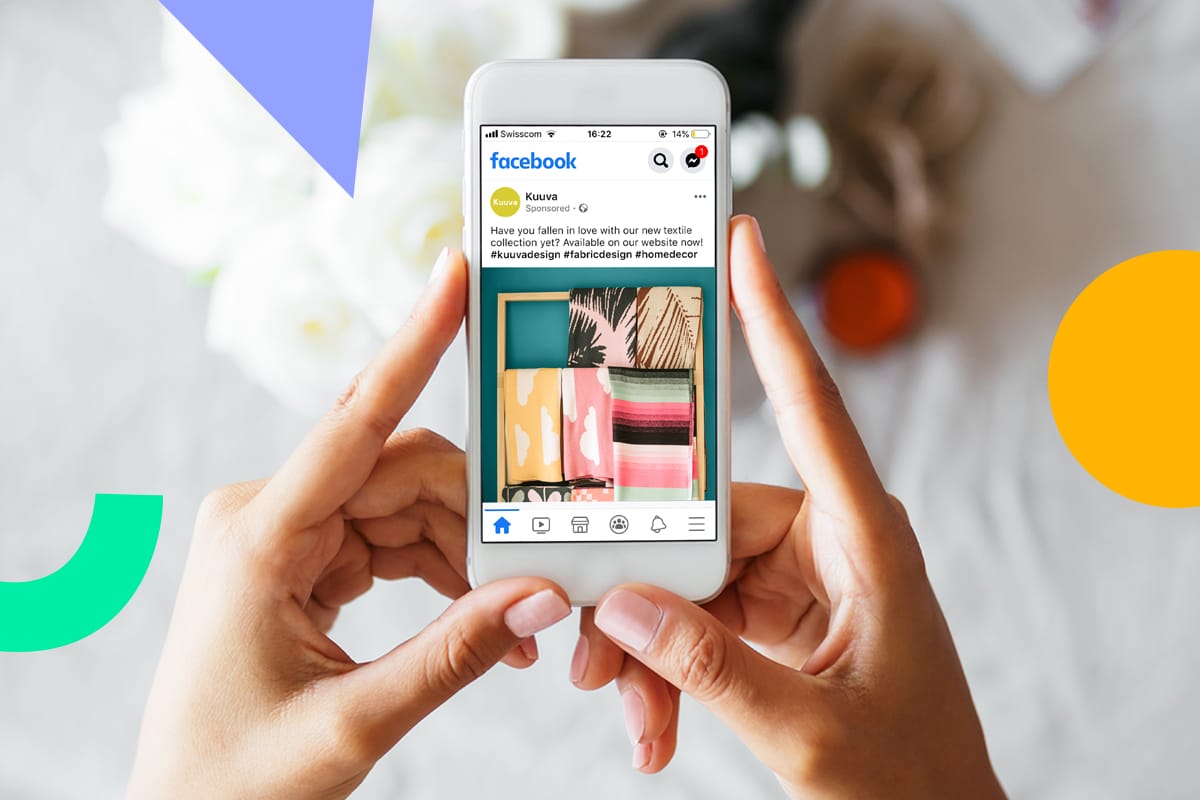E-Commerce Marketing, Facebook Ads, Paid Ads, Social Media Marketing
Facebook Ads For E-commerce
In this guide you’ll learn how to run successful Facebook ad campaigns for ecommerce in 2023.
Discover best practices for setting up (and scaling) ecommerce Facebook ads while making a profit.
This guide has everything you need to know.
Let’s dive in.
Why Advertise On Facebook?
Right now, Facebook is one of the best advertising platforms for ecommerce stores and there are 3 key reasons for this:
- Quality: Facebook has so much high-quality data you can tap into and find your perfect customers.
- Scale: With almost 3 billion active monthly users. Facebook has the audience for you to scale your ecommerce business’s growth.
- Price – Facebook advertising is still relatively cheap compared to many other ad platforms allowing you to run many ads and generate profit.
Running Ecommerce Facebook Ads [Step-By-Step]
- Technical Set Up
- Building Your Campaign
- The Perfect Facebook Ad
- Tracking The Facebook Funnel
- Scaling Facebook Ads
1. Getting Set Up
Setting up your Facebook ad account is an underrated step, you don’t want to rush this process.
Getting the technical foundation right is critical.
Take your time making sure your pixel is set up correctly, you’ve added the correct events and your website is connected properly with your Facebook business manager account.
Here’s a helpful checklist to get the technical details sorted:
2. Building Your Campaigns
Facebook advertising has changed a lot in 2023.
How-to guides from 2 years ago are no longer relevant.
A big trend in 2023 with Facebook ads is the push towards account consolidation.
In other words…
The simpler your ad account structure, the better!
Here is how your ad accounts should be structured in 2023…
The Best Facebook Ad Campaign Structure
Facebook advertising campaigns don’t require a complex campaign structure to be successful.
You don’t need to create campaigns with 30 ad sets, complex audience targeting and 100’s of different ads.
Trust Facebook’s machine learning to find your buyers and invest more time in the ad creative strategy.
An ideal Facebook campaign structure would include 2-3 ad sets with 3-5 ads. Each campaign you build will also bu built around a specific ‘theme’.
For example:
Campaign 1 – Could be focused on new customer acquisition and themed around a specific product SKU like ‘women’s black dresses’. That way when you create ads and messaging everything can be aligned to target customers shopping for black dresses.
Campaign 2 – This might be a remarketing campaign that runs dynamic product ads to site visitors who viewed products in the past 30 days but didn’t purchase.
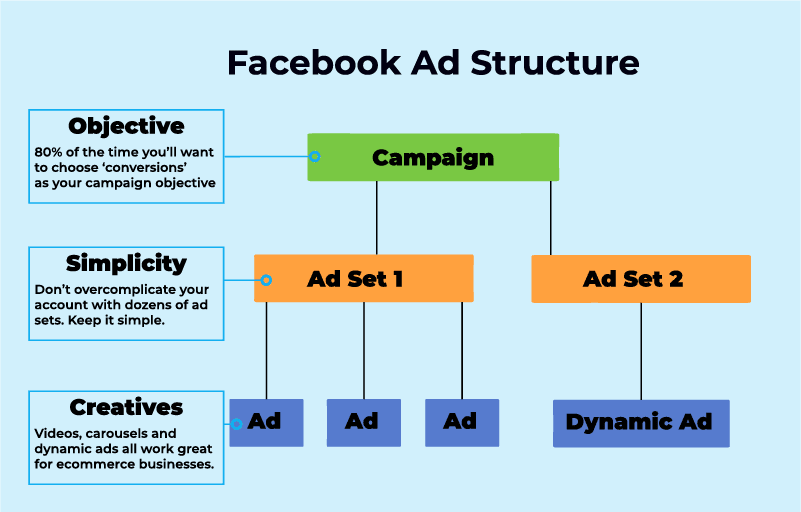
Setting Campaign Objectives & Bid Strategies
Facebook gives you a lot of campaign objectives to choose from but…
99% of the time you want to choose conversions as the campaign objective.
If you’re growing an ecommerce business profit is your most import ecommerce metric to measure success against. No other objective on Facebook ads better serves this than optimising your campaigns for conversions.
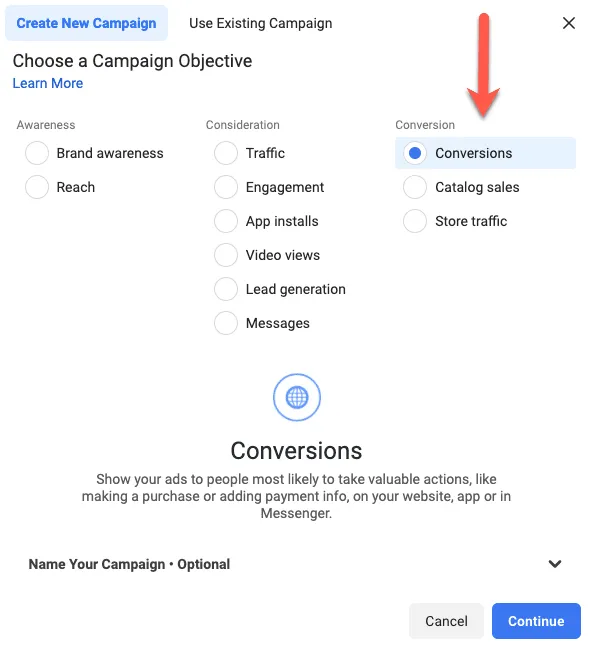
I’ll also mention that our Facebook ad agency uses CBO campaigns 90% of the time and for the bid strategy we set cost caps to protect from overspending and increasing CPAs*.
CPA* = Stands for ‘Cost Per Acquisition’ which is a measure of how much money you’re spending on advertising to acquire a new customer.

Optimising Your Ad Sets
The Ad set level of Facebook ads is where you control audience targeting and let Facebook know what goals you want to acheive.
Many ‘Facebook Gurus’ will tell you to split-test dozens of different ad sets & audiences but the truth is…
You only need a maximum of 3 ad sets per campaign and often 1 ad set is enough.
- Broad audiences (highly recommended) – The idea here is to keep your audience targeting fairly broad. Let Facebook’s powerful machine learning figure out and optimise for the right audience. Essentially here, you want Facebook to find your buyers.
- Interest Stacks – This is where you use Facebook’s detailed targeting to manually select audiences based on interests and we like to run it alongside broad audiences to see which ad sets are driving lower CPAs.
- Lookalike audiences – Although I’m not a huge fan of lookalike audiences as I find it’s hard to scale with them, they can yield some good results early in a campaign so you can look to introduce this audience targeting alongside Broad audiences & interest stacks.
A few more important tips to pay attention to at the Ad set level:
- Make sure you have selected the right Facebook Pixel that’s correctly installed on your website.
- Always make sure your conversion event is ‘purchases’ because that’s the #1 goal of your campaign. You want to advertise your products to people most likely to buy.
Audience Targeting Best Practices In 2023
Audience targeting on Facebook is where you tell Facebook who you want to show ads to.
Facebook gives you so many different possibilities here and my best advice when starting out is to keep your Audience targeting broad.
As more data comes in you can use Facebook’s analytics tool to refine this and reduce your initial audience sizes.
Interest Stacking (Detailed Targeting)
When targeting audiences, you can introduce interest-based targeting as a way of refining your target audience and optimizing your campaign. However this is often hard to scale and these audiences can degrade your ad performance over time.
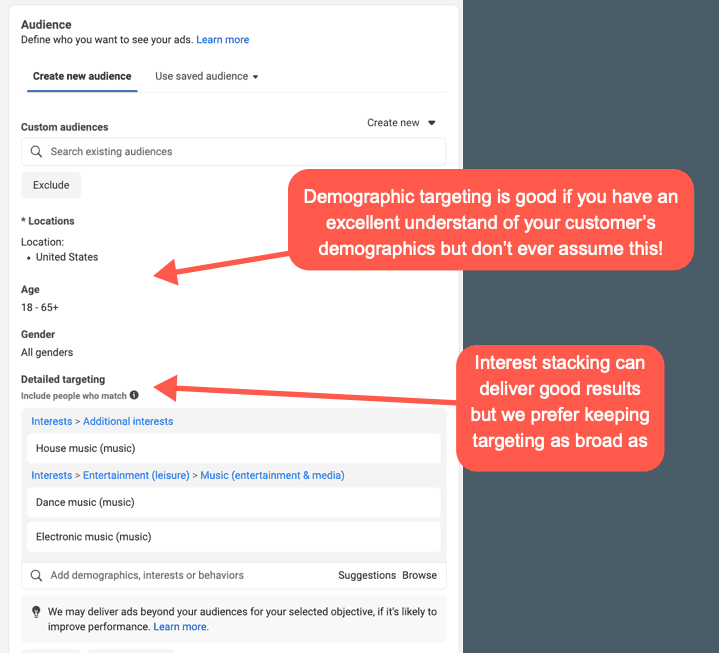
How To Choose The Right Budget For Facebook Ads
What budget should you start with for ecommerce Facebook ads?
I recommend starting with Rs.500 daily and setting cost caps based on your target CPA.
Important: You need to spend a good amount of budget on Facebook ads to reach 50 purchases required by Facebook to exit the learning phase. If you’re not spending enough to reach the required 50 weekly purchases then you will get stuck in ‘learning’ and ad performance will be inconsistent.
You may even need to spend up to 3 times your average order value (AOV) when first starting with Facebook ads. The idea here is to give Facebook enough budget so it can collect valuable data that you can use to optimise your campaign as it matures.
At a minimum you want to choose a budget based on the following:
Minimum Campaign Budget = Target CPA * 7.14 * # of Ad sets.
7.14 = the daily sales needed to exit Facebook’s learning phase within a week.
Target CPA = how much you’re willing to spend to acquire a new customer from Facebook ads.
For example:
Let’s say you have an average order value (AOV) of Rs.50 and have a target ROAS of 2. Therefore you’re willing to spend Rs.25 to acquire a new customer. You also plan on launching 1 new customer acquisition campaign with 2 ad sets for testing.
Minimum Campaign Budget = Rs.25 * 7.14 * 2 ad sets
Minimum Campaign Budget = Rs.357 daily to achieve your target ROAS of 2.
One of the biggest mistakes I see ecommerce businesses make when advertising on Facebook and Google Advertising is not allocating enough budget to achieve meaningful results. You must assign a proper budget to get through the learning phase and take advantage of Meta’s incredible machine learning and predictive conversion modelling.

3. THE PERFECT FACEBOOK AD
Ad creatives are arguably the #1 most success factors for Facebook ads.
Facebook advertising is one of the best platforms for generating and scaling your ecommerce business but there are 3 key things you need to get right for Facebook advertising to work:
- You need to have great product(s) to sell.
- Ad creatives need to be engaging & drive traffic to your landing pages.
- Your ecommerce landing pages must be optimized for conversions.
The Anatomy Of A Perfect Facebook Ad
Successful Facebook ads share 2 things in common:
- They emotionally engage customers.
- They educate and demonstrate a solution to a customer’s problem.
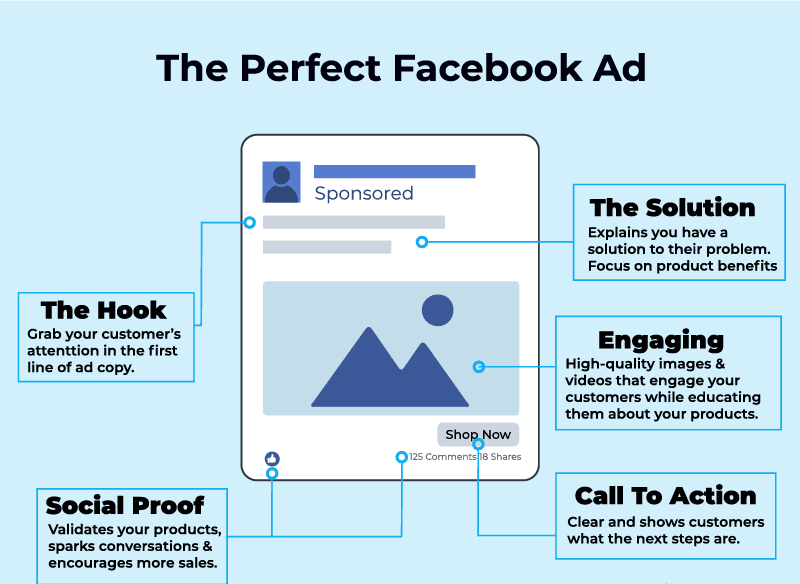
One of the key things to getting Facebook ads to work is using engaging creatives.
And more often than not, this is where a lot of Facebook campaigns fall down.Here are some 7 simple ways to improve your Facebook Ad creatives:
4. TRACKING THE FACEBOOK FUNNEL
As soon as your Facebook ads are live, you want to pay close attention to the performance of your campaign.
Otherwise, you can burn through your money quickly.
So…what should you be looking for exactly?
The #1 goal is to make sure that your Facebook Ads are generating more revenue than they cost to run.
Here are the key metrics on Facebook to watch closely:
- Ad frequency
- Cost per 1000 impression (CPM)
- Outbound clicks
- Content views
- Adds to cart
- Checkouts initiated
- Purchases
- Return on ad spend (ROAS)
Return On Ad Spend (ROAS)
One of the most important metrics on Facebook to pay attention to is your ROAS.
This KPI is critical to understanding if Facebook is producing a positive return on investment for you and lets you know when you’re ready to scale up your Ad spend.
When it comes to ecommerce, every store will have a different ROAS they want to achieve to be profitable. For your ecommerce store, you might calculate the following:
ROAS of 3 = Breakeven point
ROAS of 4 = Making Money
ROAS of 5 = Crushing it
Before running your Facebook campaigns make sure you work out your breakeven ROAS number so you can set some clear goals for your campaign.
5. Scaling Facebook Ads For Ecommerce
A word of warning…
Scaling Facebook ads is an advanced level of Facebook marketing and you should already be getting a few sales from your initial Facebook campaign before trying to scale.
FINAL THOUGHTS…
Congratulations! You have everything you need to launch and scale a successful ecommerce Facebook ads campaign.
It’s over to you.
Which Ecommerce Facebook Ad tip did you find most helpful from this post?

